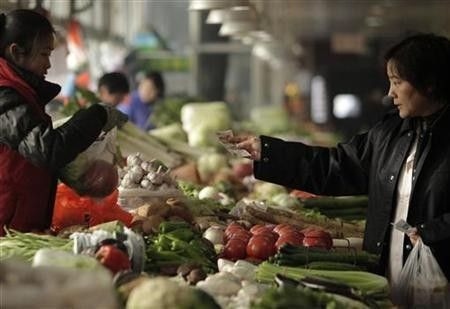China’s Annual Inflation Spiked, Forcing a Market Rethink of Policy Easing Expectations

China's annual inflation spiked to a consensus-busting 4.5 percent in January as spending jumped during the Chinese Lunar New Year holiday season, breaking a five-month softening trend and forcing a market rethink of policy easing expectations.
A customer pays for her vegetables at a market in Beijing January 12, 2012.
The size of the seasonal distortion makes the January data particularly hard to read, but economists say it is likely to have squeezed out any remaining expectation of a near-term cut to bank reserve ratio requirements (RRR), a move confidently predicted in the run-up to Lunar New Year but which failed to materialise.
The CPI does cut into room for further monetary policy easing for now. We don't think there will be an RRR cut before March, Wei Yao, China economist at Societe Generale in Hong Kong, told Reuters.
Markets showed little reaction to the data.
Inflation rebounded from a 15-month low of 4.1 percent in December. The consensus inflation forecast, also 4.1 percent, was blown away by a 10.5 percent surge over a year earlier in food prices, which make up roughly a third of China's consumer price index.
Non-food prices rose 1.8 percent in January on the year, below December's 1.9 percent while producer price inflation came in slightly below consensus at 0.7 percent, underlining easing inflation pressures in the factory sector as global demand is dampened by Europe's festering debt crisis.
The distorting impact of the Lunar New Year has led the government to delay the release of factory output, investment and retail sales data for January. It will combine them with February numbers published in March to smooth out the impact.
The central bank is more likely to maintain its current monetary stance for now and may wait for February data to decide on its next policy move, said Wang Jin, analyst at Guotai Junan Securities in Shanghai.
The People's Bank of China cut the RRR in November for the first time in three years, taking 50 basis points off the record 21.5 percent level.
More cuts are expected in coming months. A Reuters poll in January forecast a total of 200 bps through 2012, though the central bank has opted in recent weeks for open market operations to inject short-term liquidity into the financial system to keep credit flowing.
Few economists believe the central bank will cut outright lending rates this year while annual inflation stays stubbornly higher than the one-year deposit rate of 3.5 percent. A cut could prompt Chinese to divert their bank savings into more speculative investments, such as the stock market.
EASING TREND INTACT
Provided January's jump higher does not turn into a trend, many economists expect inflation in February to soften and continue the pattern through 2012 to come in below 4 percent for the year as a whole, allowing Beijing to maintain a gradual, targeted easing of monetary and fiscal policy.
With demand weakening this year, we believe disinflationary pressure will continue to exert itself through 2012, bringing full-year CPI to around 3.5 percent, Ren Xianfeng, senior China analyst at IHS Global Insight in Beijing, said in a client note.
There remains plenty of downward momentum in China, despite a moderation in the slowdown. The property market remains in the throes of a correction, which is dragging down investment spending and spreading deflationary pressure.
The central bank has been easing policy gently since late last year to maintain money supply and credit creation to underpin economic growth, which is forecast to slow to 8.2 percent in the first quarter from 8.9 percent in the previous quarter, a Reuters poll shows.
Financial markets broadly believe that an outflow of capital from China in the fourth quarter of 2011 prompted the November RRR cut as the central bank sought to boost domestic credit growth to maintain a consistent expansion in money supply.
The slightly softer rate of producer price inflation underscores the potential for downside surprises for corporate China as a deteriorating global backdrop knocks demand for goods from the factories of the world's second-largest economy.
China's pro-growth policy stance has replaced fighting inflation as the most urgent priority against that uncertain global outlook.
But Chinese officials warn against complacency on inflation, wary that a spurt higher in consumer prices could spark social unrest ahead of leadership changes due later this year.
The leaders are aiming for a minimum rate of economic growth of 7.5 percent this year and annual inflation near 4 percent, sources familiar with government plans told Reuters last month.
A near-term risk to consumer prices could come from rising fuel prices after China on Wednesday raised the ceiling for retail prices of gasoline and diesel by 3 to 4 percent.
It was the first hike in 10 months and a move that lifts prices to record highs and also a signal that China will use the tamer inflationary backdrop to pursue market reforms, which could further constrain any aggressive monetary easing.
With falling CPI inflation, Beijing will likely seize the opportunity to raise regulated prices such as power tariff and may even carry out other price reforms, like on gas, economists at Bank of America/Merrill Lynch wrote in a client note.
© Copyright Thomson Reuters 2024. All rights reserved.





















